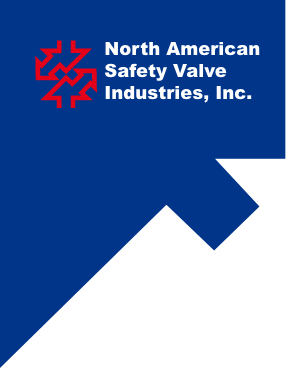Supply the following information: |
Example: |
| 1. Quantity of Valves | 4 |
| 2. Size of Valve Inlet and Outlet | 1 ½” x 2” |
| 3. Type, Model or Figure Number | 1905FC |
| 4. Manufacturer | Consolidated |
| 5. Inlet and Outlet Flange Rating and Facing | 150 x 150, RF, ANSI |
| 6. Body Material | Steel |
| 7. Trim Material | Stainless Steel |
| 8. O Ring Seat Seal Material, if required | Teflon |
| 9. Set Pressure | 125 psig |
| 10. Required Capacity | 2,390 lb./hr. |
| 11. Type of Service (Flow Medium) | Steam |
| 12. Operating and Relieving Temperature | 274-298 degrees F |
| 13. Back Pressure-Constant or Variable Amount | 0 |
| 14. Allowable Overpressure | 10% |
| 15. Accessories (Cap, Lever, Gag, etc.) | Open Lever |
Take the Mystery Out of Ordering Safety Valves
If you don’t know your blow down from your pop action, NASVI has you covered. Here is a handy cheat sheet on safety valve lingo and how to accurately order them.
General Information and Definitions
SAFETY VALVE: Safety valves or pop safety valves are automatic, direct-pressure actuated, pressure-relieving devices for use in vapor or gas services.
SAFETY RELIEF VALVE: Safety relief valves are basically like pop safety valves and are primarily for liquid service where the thermal expansion in a liquid-laden vessel actuates the valve. When vapor is generated in these vessels, due to uncontrolled heat input, this valve with the huddling chamber, will give a high disc lift and discharge the expanded vapors. This valve is also suitable for gas or vapor service.
SELECTION OF VALVE: Valves should be selected for the particular installation on which they are to be used and also on the basis of the rated discharge capacity. This should be equal to or greater than the maximum output of the system.
INSTALLATION: The valve is to be installed in a vertical position, into a clean fitting, using the proper size and type of wrench so as not to damage the valve. The discharge piping, without stop valves, shall be independently supported and sloped downward slightly to drain condensate.
OPERATING PRESSURE: The actual pressure at which a vessel is maintained in normal operation.
ALLOWABLE WORKING PRESSURE: Maximum design pressure of a new vessel in accordance with applicable codes.
SET PRESSURE: The pressure at which the valve opens.
BLOWDOWN: The difference between the pressures at which a pop type safety valve opens and closes.
POP ACTION: The sharp opening action of a safety valve when operating with steam, air or other compressible fluids.
WARN: This is the sound in the valve immediately preceding the pop. This is also called a “simmer.”
DISC: The moving member of the valve, which is held down by the spring and is lifted by the water, vapor or gas pressure.
